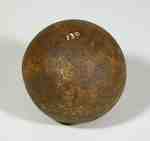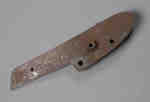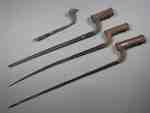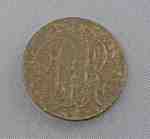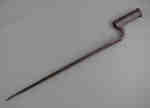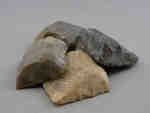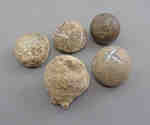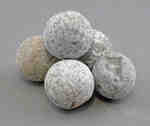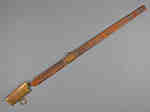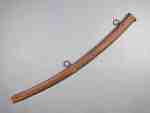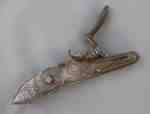Results
- A metal bayonet sheath, measuring 23 ¼ x 1 1/2 . This item can currently be found at the Willoughby Museum.A metal bayonet sheath, measuring 23 ¼ x 1 1/2 . This …
- A 10 pound cannonball that is believed to have been used by either American or British forces. It was found near Nelles Blvd, in Grimsby, on land belonging to Col. Robert Nelles at the time of the WaA 10 pound cannonball that is believed to have been used by …
- This is a musket action piece that has ornate markings on one side. This item is currently on display at the Battleground Hotel Museum.This is a musket action piece that has ornate markings on one …
- These are a few examples of steel bayonets from the War of 1812-1814. The largest bayonet’s base (most likely British) measures 10cm long, 2.5cm in diameter and the blade is 41.5cm long and 2.5 cm wiThese are a few examples of steel bayonets from the War of …
- A remnant of a canister shot. This form of ammunition, also referred to as a grape shot, was fired at an angle from a cannon and released a spread of shot towards enemy lines. The raking effect produA remnant of a canister shot. This form of ammunition, also referred …
- This is a copper powder flask with a raised pattern of leaves with a bird in the center on both sides. The top can be removed by unscrewing. The top is measured 5cm x 3.5 cm (at base) and 1.5 cm diamThis is a copper powder flask with a raised pattern of leaves …
- Button has letters R.R intertwined with no shank on the reverse. Diameter is 1.5 cm.Button has letters R.R intertwined with no shank on the reverse. Diameter …
- This is a bayonet that would have been designed to fit on the muzzle of a Brown Bess musket. There is an inscription on the base of the stock that looks to be an underlined “A” with “33” below.This is a bayonet that would have been designed to fit on …
- A homemade bayonet that was designed to fit on the muzzle of a rifle or musket. It is of the styling favored most by the militia units during the War of 1812. Its unique length and lack of a rear reiA homemade bayonet that was designed to fit on the muzzle of …
- This is a bayonet that would have been designed to fit on the muzzle of a rifle or musket. Unique markings include a crown with the inscriptions “40”, “WHEELER”, “O”, and a “V” on the front of the blThis is a bayonet that would have been designed to fit on …
- This bayonet would have been designed to fit on the muzzle of a Brown Bess musket. It is slightly bent at the tip and unique markings on the blade include: a crown with “31”, “I. Salter” and what looThis bayonet would have been designed to fit on the muzzle of …
- This is a black leather bayonet sheath that measures 37.5cm in length. There is also a frog clip that was used to mount it on a belt. Stamped into the sheath near the frog clip are the markings: “E”,This is a black leather bayonet sheath that measures 37.5cm in length. …
- This is a piece of flint that was unearthed at one of Niagara’s Battlefields. It would have been used to light a flintlock musket when firing at the enemy.This is a piece of flint that was unearthed at one of …
- These musket balls were found at one of Niagara's battlefield sites. It appears, due to their deformation, that they have been fired from a musket.These musket balls were found at one of Niagara's battlefield sites. It …
- A collection of musket balls found at one of Niagara's battlefield sites. Sizes range from 1.8 to 1.5 to 1.2 cms.A collection of musket balls found at one of Niagara's battlefield sites. …
- A scabbard with a gilt top was part of an infantry officer’s sheath, pattern 1796. It is black leather with gilt binding, frog clip and sash ring. The top gilt piece has become detached from the leatA scabbard with a gilt top was part of an infantry officer’s …
- A steel military scabbard that is curved with two metal bands with a ring attached to each. The metal is dull and rusty and the tip is broken off.A steel military scabbard that is curved with two metal bands with …
- A curved steel scabbard that is said to have been found on the Lundy's Lane Battlefield by W. W. Woodruff.A curved steel scabbard that is said to have been found on …
- A British Officer’s sword and scabbard. The scabbard is black leather with a brass tip and collar with a ring. The sword has an urn hilted pommel with a fixed guard and the hilt is wrapped with wire.A British Officer’s sword and scabbard. The scabbard is black leather with …
- A musket action with “TOWER”, a crown and the Royal cipher “GR” engraved on one side.A musket action with “TOWER”, a crown and the Royal cipher “GR” …
When selecting an individual record or object, you will move
to the website of the heritage institution that houses the item.
To return to the search or results pages, select "Back", "Results" or "New Search".
 This project was made possible with the support of the Department of Canadian Heritage
This project was made possible with the support of the Department of Canadian Heritage
through the Canadian Culture Online Strategy.
to the website of the heritage institution that houses the item.
To return to the search or results pages, select "Back", "Results" or "New Search".
 This project was made possible with the support of the Department of Canadian Heritage
This project was made possible with the support of the Department of Canadian Heritage through the Canadian Culture Online Strategy.








